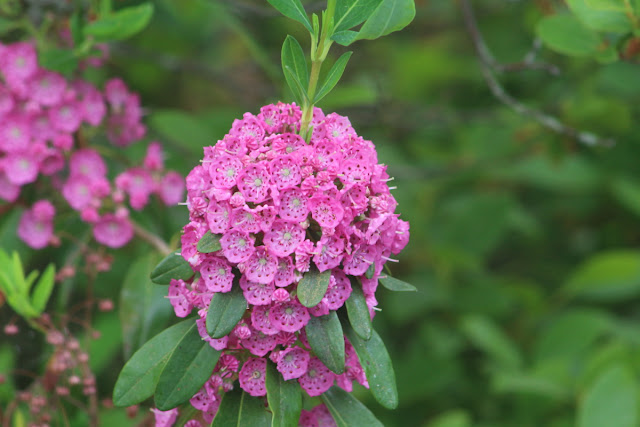 |
| Sheep Laurel (Kalmia angustifolia) |
 |
| Sheep laurel is often seen along the shoreline |
 |
| The flowers measure about a half an inch across |
What I didn't know about this plant until Linda saw a post by the Society for the Protection of NH Forests, is that sheep laurel has evolved an unusual defense mechanism to fight off both plants and animals that might like to attack it. The most unusual trait is called "allelopathic", which means its roots give off chemicals that inhibit the growth of other plants, especially conifers. [Ref: New England Wildflower Society] That seems like a pretty good way to keep away competitors for light and water. It is also poisonous to livestock including sheep and cattle, thus the source of its common name of "lambkill", and another good survival trait.
Sheep laurel is a particular problem for blueberry fields, as it has stronger rhizomes and sprouts faster than blueberries; it has to be actively managed in commercial blueberry fields. [Ref: US Department of Agriculture]
 |
| Sheep laurel growing amidst blueberries |
Early one morning this week I took a long walk along the lake and through the woods; it was a beautiful, peaceful morning with birds singing all the way, including a rose-breasted gross beak in a thicket beside a field, which I rarely see, and even then far too deep in the branches to get more than a glimpse of it. I saw no other creatures on the whole long walk. Until that is, I came right back to my own yard, where I found someone waiting to greet me.
 |
| Just lumbering along, looking for breakfast |
Then just a little motion on my part, and he high-tailed it out of there!
 |
| On the retreat |
But look at the size of those feet.
And you certainly wouldn't want to tangle with those claws.
 |
| Large claws. Big ears too. |
Bears are omnivores and will wander all day, consuming anything they come across, from berries to bees to carrion. Which brings me to turtle eggs, which they will also gladly consume. Has anyone found holes dug in sand or soft soil near the water? I saw that much of the bare ground on Smith Island was dug up and looking rather like a mine field.
 |
| A reptilian moonscape |
Here is the likely culprit, courtesy of the eye and camera of Amy Wilson:
 |
| A sunning snapping turtle. Photo by Amy Wilson |
Finally, a loon update: At last report, there are still two nests with an unknown number of eggs being incubated.

































